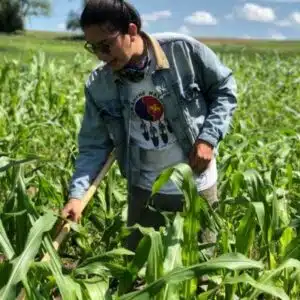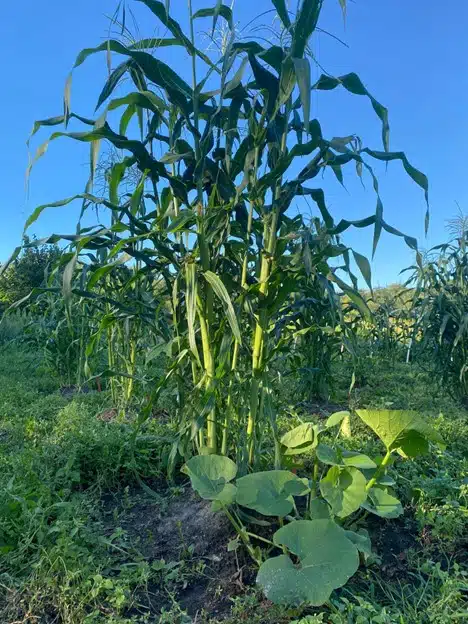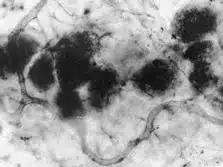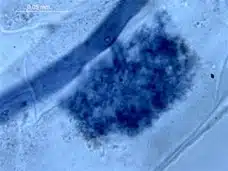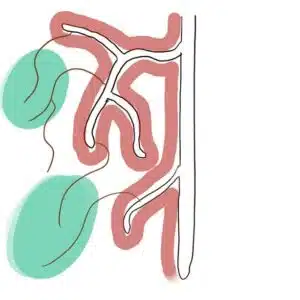The Potential Role of Microbes in The Three Sisters: Part I, The Good Microbes by Daniel Hayden
This guest blog is published as part of the 2022-2023 “Equipping Next Gen Ag and Conservation Leaders” mentorship program hosted by the Mississippi River Network and Green Lands Blue Waters. See all twelve communications projects completed by the mentees here. You can read more about the entire program at https://greenlandsbluewaters.org/next-gen-ag-leaders/
Daniel Hayden, Plant Pathology PhD at University of Wisconsin-Madison (WI)
Daniel has always held working with and serving Indigenous people as a core value, and as a PhD student at UW Madison, he found a way to utilize his interest in plant science to serve the tribal community. Daniel’s research focuses on collaborating with tribal corn growers to help them optimize reduced-tillage practices. This work has highlighted the many challenges these farmers face, as well as the way in which their knowledge and values support equitable, dynamic, sustainable, and productive agricultural systems. Daniel’s goals are to farm Indigenous crops, support and teach tribal youth, and continue collaborating with tribal communities through research.
Daniel’s Final Communications Project: Daniel Hayden shared his PhD research in a blog series on the potential role of microbes in The Three Sisters traditional polyculture mound system. “Part 1” of Daniel’s blog series is reproduced below.
Join our
COMMUNITY
And Get a Free E-book!
When you sign up as a River Citizen you’ll receive our newsletters and updates, which offer events, activities, and actions you can take to help protect the Mississippi River.
You’ll also get our free e-book, Scenes From Our Mighty Mississippi, an inspiring collection of images featuring the River.

The potential role of microbes in The Three Sisters, Part I: The good microbes
By Daniel Hayden
Despite not being visible to the human eye, microorganisms like fungi, bacteria, and viruses play such pivotal roles in our world. All of human history has been dictated by microbes, from fermentation of our foods to pandemics like COVID-19. Plants are no different, as interactions with microbes have driven plant evolution leading to many of the interesting aspects of plants we see today. Recently, there is a growing interest in how microbes influence plants in agriculture and how scientists can make the microbes work for us to produce better crops and healthier soil.
The development large-scale agriculture mainly focused on the crop, breeding and engineering to increase yield and create uniformity. It makes sense… the crop is producing the fruit/seeds so you need to protect the crop at all costs through fertilizers, pesticides, and reducing weed competition via tillage. However, this thinking often overshadowed other aspects like soil health and microbes, which are inherently connected.
In this post, I’ll discuss why traditional forms of agriculture don’t need chemical inputs, machinery, or genetically-engineered crops, but rely on the time-tested interactions between plants and microbes. The example I will use has existed in North America for time immemorial and practiced by Indigenous peoples: The Three Sisters.
The Three Sisters mound system, is a traditional polyculture of corn, beans, and squash grown on a mound of soil. Each crop has it’s own job within the polyculture: corn provides structure for beans to climb up to reach sunlight, beans provide nitrogen via an association with nitrogen fixing bacteria, and squash provide shading to retain soil moisture and suppress weeds. This is a very general rundown of the Three Sisters, as there are many stories and knowledge throughout many cultures. This post is focused more on the microbial relationships, so I recommend reading the plethora of knowledge online or asking family and community members if you want to gain more general insight.
About 450 million years ago, plants transitioned to living on land looking similar to mosses and liverworts. Living on land provided many new challenges, mainly nutrient acquisition as tiny roots can only travel so far in the soil. To overcome these challenges, plants formed a bond called mycorrhiza with fungi. The deal was fungi live in the roots of plants and grow out into the soil, gathering and sending hard to reach nutrients back to plant. In return, plants provide the abundance of carbon gained from photosynthesis to the fungi. Sounds fair and evolution favored this association as now about 80% of land plants still form mycorrhiza; even weirder is mycorrhizal fungi resembles an ancient relic, the same as they did 450 million years ago. A true example of if it ain’t broke, don’t fix it. Recent research has revealed mycorrhizal networks, which is when the fungi living on the roots of one plant connect to another nearby plant. This had big implications as plant communities like a forest or prairie are potentially sharing nutrients and even sharing signals. Something to note is that there are different types of mycorrhiza, but the type most common and described here is called arbuscular mycorrhiza. These fungi actually form structures inside plant roots as seen in the pictures below.
Right image: 450 million mycorrhizal fungi in ancient root cells (Source: Mycorrhizas.info). Left image: Modern staining of mycorrhizal fungi in roots (Source: i-beg.eu). These structures are called arbuscules, a distinct structure of these common mycorrhizas.
All crops in the Three sisters form mycorrhizal associations, as not forming mycorrhiza is more of the exception. The main nutrients taken up by mycorrhizal fungi are nitrogen and phosphorus, which are the important ones for plant health and development. In the Three Sisters, a common practice is actually placing fish fertilizer in the mound before planting. The mycorrhizal fungi would optimally utilize these nutrients for these crops, as roots cannot reach all nutrients in the soil.
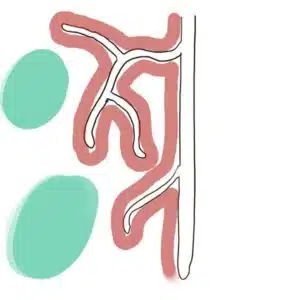
This is a diagram of a root, where the red represents areas where nutrients have been depleted and the green is sources of nutrients. On the right side, the brown mycorrhizal fungi extends into these areas.
Furthermore, mycorrhizal fungi produce proteins called glomalin, which influence soil structure and nutrient availability, but how long it takes to see these results is probably several years. Most changes in soil like nutrients or even structure generally occurs over the course of years. I believe in Three Sisters mounds glomalin produced by mycorrhizal fungi improve both soil quality over time.
I hypothesize not only are these fungi playing a big role in ensuring these three crops acquire nutrients, but there is an underground network of mycorrhizal fungi allowing for potential sharing of nutrients. This makes sense in a spatial sense, as all three crops and multiples of each crop, are growing closely together on a mound of soil. The general trend I see is corn grown on the very top of the mound, beans next to the corn, and squash is planted on the side of the mound or on the ground near the mound. Inside the mound, the bean and corn roots would be closely interacting, while the squash roots would be not as close to them, but maybe further beneath the mound. The corn and bean root relationship may have developed due to how much nitrogen corn needs and how beans can provide potential sources of nitrogen. Plant ecology research indicates grasses (corn) and legumes (bean) have greatly influenced each other’s evolution.
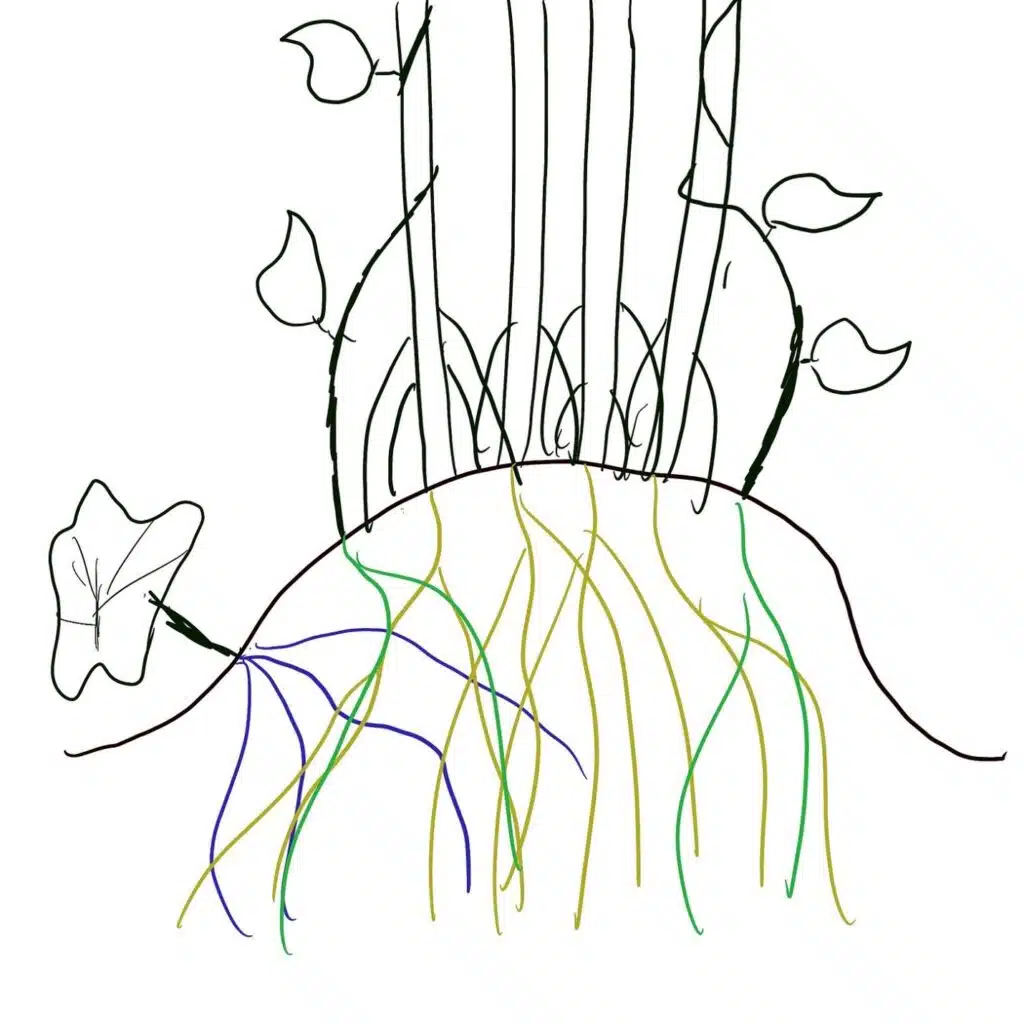
Unlike mycorrhiza, only the bean plants reap the direct benefits of this relationship. No extra nitrogen is being released actively in the soil. The only way this nitrogen can be taken up by the corn or beans would be from dead bean roots and bean leaves decomposing in the soil. This occurs slowly and would not be enough to fully supplement the other crops when the bean plant is alive. After harvest, the nitrogen rich roots would be in the soil and have direct benefits the following season. This is why farmers now will rotate between corn and soybeans as the soybean debris in the field will turn into fertilizer for next season’s corn.
This would explain why traditionally a fish fertilizer is often placed in the mound, but maybe those mycorrhizal associations and networks may be optimally using that nitrogen. A huge issue in the Midwest is runoff from agriculture, where nitrogen fertilizer escapes the fields and creates negative effects in water sources. The simple explanation is the plants aren’t getting nitrogen efficiently, if much of it is ending up in water sources. I would say that beans give a temporal benefit of adding supplemental nitrogen to soil each year while initial fish fertilizers addressed initial N needs.
Summary:
We know all three crops form a beneficial relationship with mycorrhizal fungi, which may help in optimal nutrient acquisition and potentially sharing nutrients between crops. Furthermore, mycorrhizal fungi influence and improve soil structure over time, which could be happening in the soil mounds. I suspect the role of beans is more temporal, year-by-year basis, meaning those nitrogen benefits directly help the bean immediately and over time the buildup of nitrogen-rich bean plant debris in the soil will add more nitrogen. These microbes are allowing these crops to optimally uptake nutrients in tandem with the crops ability to co-exist together. We need to think about the microbes as a valuable community around The Three Sisters because they have been inherently connected with these Three crops for time immemorial and can greatly influence crop and soil health.
Next Post:
No plant interacts with just one microbe, what I have described is a small part of these plant-microbe interactions. So far I have talked about beneficial microbes, but there are millions upon millions of microbes living in the soil and all over the plant, many of them we don’t even really know if they’re good, bad, or neutral. In this next post I’ll discuss the communities of microbes and the bad microbes.
Find Daniel Hayden’s blog series here on the potential role of microbes in The Three Sisters traditional polyculture mound system.
Sources:
Kapayou, D. G., et al. “Reuniting the Three Sisters: collaborative science with Native growers to improve soil and community health.” Agriculture and Human Values 40.1 (2023): 65-82.
Irving, Thomas B., et al. “A critical review of 25 years of glomalin research: a better mechanical understanding and robust quantification techniques are required.” New Phytologist 232.4 (2021): 1572-1581.
Treseder, Kathleen K., and Katie M. Turner. “Glomalin in ecosystems.” Soil Science Society of America Journal 71.4 (2007): 1257-1266.
Taylor, Thomas N., et al. “Fossil arbuscular mycorrhizae from the Early Devonian.” Mycologia 87.4 (1995): 560-573.
van Der Heijden, Marcel GA, et al. “Mycorrhizal ecology and evolution: the past, the present, and the future.” New phytologist 205.4 (2015): 1406-1423.
Vandermeer, J. H. 1992. The Ecology of Intercropping. Cambridge University Press.
Andrews, Mitchell, and Morag E. Andrews. “Specificity in legume-rhizobia symbioses.” International journal of molecular sciences 18.4 (2017): 705.
Smith, Douglas R., et al. “Surface runoff and tile drainage transport of phosphorus in the midwestern United States.” Journal of environmental quality 44.2 (2015): 495-502.
Durian, Emma, and Monica Carroll. “American Agriculture and How Mexico Pays For It: How Midwestern Agricultural Runoff Has Cost Gulf Economies.” (2022).
Step 1
Become a River Citizen
Yes! The River can count on me!
I am committed to protecting the Mississippi River. Please keep me informed about actions I can take to protect the Mississippi River as a River Citizen, and send me my free e-book!, Scenes From Our Mighty Mississippi!
Step 2
LEARN ABOUT THE RIVER
We protect what we know and love. As a River Citizen, you’ll receive our email newsletter and updates, which offer countless ways to engage with and learn more about the River. You can also follow us on Instagram, Facebook, X (Twitter) , and YouTube, where we share about urgent issues facing the River, such as nutrient pollution, the importance of floodplains and wetlands, and bedrock legislation such as Farm Bill Conservation Programs.
Step 3
Take Action
There are many ways you can jump in and take action for a healthy Mississippi River. Our 10 actions list includes simple steps you can take at any time and wherever you are. Check out our action center for current action alerts, bigger projects we are working on, and ways to get involved.

